AMD Duron 950
Yep it is that time again, and to tie in with
Computex, AMD are launching the 1.4 TBird and the Duron 950.
The Duron 950 really comes as no suprise to us, as this is a common step for the
Duron core.
As we say every time, AMD have done very well to pull the market around and ever
since the launch of the Slot A Athlon they have dominated the market and have
left Intel worrying. I personally didn’t move to AMD until I got an Athlon as I
was an Intel user. Since then I haven’t looked back. My home system is even an
AMD based unit. Intel tried to catch up with the pushing of the Celeron 2 which
I haven’t seen much lust or need for within the market. With the pushing of the
CPU Bus speed to 100 MHz on the Celeron 2 still didn’t increase performance
*that* much.
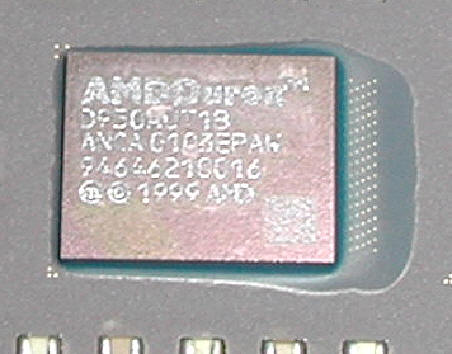
AMD directly competed with Intel on the budget market. Two years ago Intel
dominated the entire market, and AMD have quickly shot back with a series of new
cores and architectures. If Intel's P4 had taken off, perhaps we would be in a
different situation. Even with the release of the Xeon P4s which still lacked in
any major performance, Intel should be worrying. With an Athlon 1.2 GHz
outperforming a single Xeon P4 in many processes, I wonder what Intel will do
about the 760 MP Platform....
Some people have said that there hasn't been anything due in the future which
will have the hype of the P2s, or Athlon. But I think this is wrong, with the
introduction of the desktop Palomino this should enable faster speeds, and also
the performance of a high end server (2P and 760MP platforms) we should see even
more performance. I personally would hold off upgrading for the next few months.
AMD have always been competitive on price, and I believe that they are dedicated
to making sure that Intel will always be the expensive partner. The main issue
that AMD have to overcome is that most companies will only go with Intel
chipsets. Don't ask me why, but that's the way it is. With the release of the
Athlon 4 in the mobile market and the porting of the KT133A chipset to a laptop
interface AMD has a good position to abuse this point in the market.
As we have already shown and as a lot of you out there know, the Duron is an
amazing CPU. Its primary aim is for performance and value for the home desktop
user. It is for budget not for POWER. But this is somewhat a different schema to
what AMD have done. So AMD have released another speed increment to enable the
user to have this unforseen power.
While AMD has a good end number of end users and mostly they sell to the end
user directly either via mail order or retail outlets, they currently don't have
lots of OEMS on their side. But this seems to be changing rapidly. Especially
with the recent release of the AMD 760MP (2P) based platforms. And the release
of the mobile range, both of which appear to be adopted by many OEMS and system
builders. So why hasn't it taken off as well as Intel? Well Intel firstly have
the blue men running all over the place, and also the noise, the "dum dee dee
dum". This is something which users hear on the radio or the TV and it sticks. I
personally don’t see why AMD CPUS haven’t been adopted by so many OEMS as if you
look at the performance it beats it all over, forget about the price, this unit
is powerful.
So what does the 950 offer which no other CPU offers on the market? Well this is
hard to say... Technically it is just a speed increase, or is it just another
nail in the Intel coffin?
Testing.
Ever since I tested the Abit KT7E motherboard I have been most in love with it,
for performance and price it is a definitive main board that all should use. So
we have decided to change to this board for testing in our labs, coupled with 2
* 128 MB PC133 Cas2 Crucial Memory modules this is a power house. This board has
all the features which the user needs, the reliability, performance, and of
course a nice price tag (~£75)... oh and it is blue ;)
The DDR based reviews will all be conducted on a DDR Reference platform with
512MB DDR ram, why did we make this choice? Well we are sure that most high end
users who will be looking at DDR will be running this much
Test Rig :-
AMD Testing System : -
Mobo - AMD Reference 760 Motherboard (ABit KT7E for the Duron)
Graphics Card - Visontek Geforce 3
Memory - 256MB Crucial PC133 Cas 2 RAM (256MB for DDR)
Cooling - Vantec Cooler
HD - 18GB Quantum Atlas 10K II
CD/DVD - Teac 32X CD ROM
Sound - SB Live 1024
Network - Intel Pro 100 Management
Intel Testing System :-
Mobo - Abit VP6 / Asus P3V4X for Celerons 2s
Graphics Card - Asus Geforce Pure 64MB
Memory - 256MB Crucial PC133 Cas 2 RAM
Cooling - GlobalWin WBK38
HD - 18GB Quantum Atlas 10K II
CD/DVD - Teac 32X CD ROM, 6X SCSI DVD ROM
Sound - Sound Blaster Live Platinum
Network - 10/100 3Com Management Card.
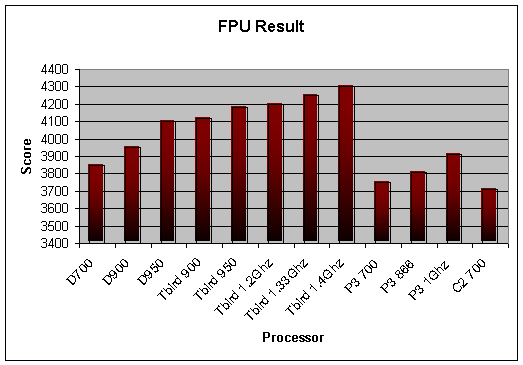
From this graph you can see in the FPU results the 950 Duron is giving a good battle against the 900 Thunderbird and beating all of the other Intel CPUS!
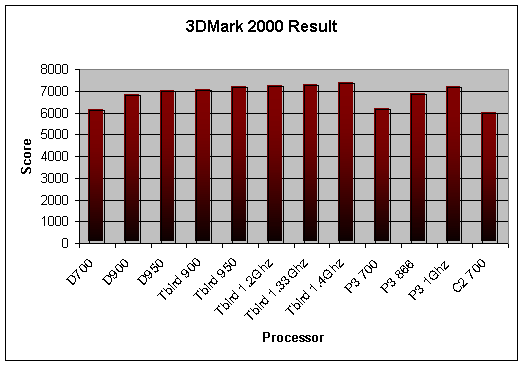
In our tests we used 3DMark 2000, the reason for not using 2001 is that we believe that 3DMark shows more graphics card need than CPU. But the CPU does have an impact. And as a lot of you readers know what your system will get under 2000 then it seems best to stick to it ;) As you can see the Duron 950 is only a little bit behind the TBird 950.. not bad for a budget unit
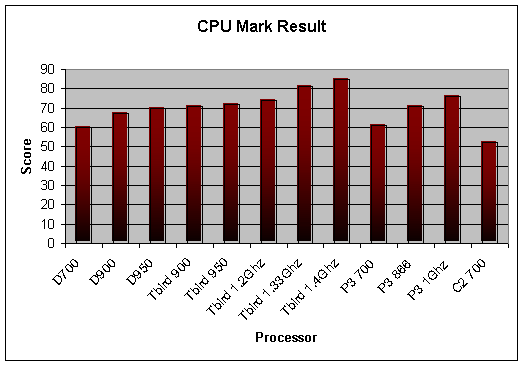
Again we see the 950MHz Duron putting up a good fight. This unit is an exceptional budget CPU.
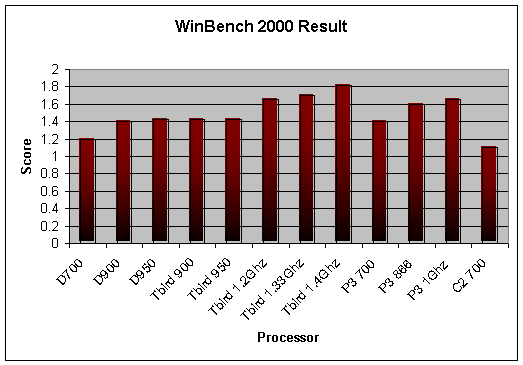
In Winbench the aim is to have a higher score, this software is for hardcore processor usage. As you can see they are all fairly close to one another but the 1.4 GHz thunderbird, just steps out ahead of the other CPUs. With the Duron 950 still putting up a good fight ;)
The Duron runs on the 100MHz Main FSB, but using AMD's step up issues, it
delivers higher bandwidth of 200MHz inside the Core (Ev6 DDR Bus). The L1 Cache
on the CPU (designated for Data and instructions, 64KB for each) and the Large
64KB L2 cache, means that the Duron is a cheap chip but has a VERY good
performance. Right up there with the TBirds but under 1/2 the price ;)
So what? Yep I can hear you saying that. Well in the next 6 months we will see a
lot of changes. With the ending of the Duron and the TBird, and replacement of
them by the Morgan and the Palomino, which will move in to 2P and also in to
Desktop and mobile ranges. This will have a large effect on the market,
especially with companies such as Epox, ABit, and MSI working on a budget
version of the 760MP board. AMD know that their cores run hot at the moment, but
with the introduction of the new cores which should run 20% cooler, and the
Palomino not even needing a fan on the heatsink, this will make a big
difference!
So far what we can say is that this new speed for the Duron yet again shows it
is a cost effective price for a performance unit. It is a good speed and it is
well worth upgrading to even for the people running 700 Durons who should
consider the jump to this new unit. It is perfect for the market AMD have
developed it for. they don’t work like Intel with "disabling features on a
product", they just built a budget unit. It is built for the demand within the
market.
AMD only produce chipsets to launch there products on the market, and it is very
dependant on other companies to develop and release chipsets and support them.
This means that the market could be affected by the quality or performance of
these chipsets. They are totally reliant on VIA, ALi, and SiS.
The main differences between the Athlon and the Duron are that the 60% cache on
the Duron means that it needs more memory bandwidth to increase its performance.
Data that the CPU doesn’t have within L1 or L2 has to be seeked from the main
memory this means that this memory needs to be high bandwidth and performance or
the system will slow down in speed, as it has to idle whilst waiting for this
information. But until the launch of the Kt133E chipset from VIA the memory
performance on any platform designated for the Duron was poor and less than
adequate.
If you aren’t after a total budget system with integrated video and audio, but
you cant afford the high costs of the Thunderbird core, this CPU coupled with a
KT133/A chipset is a sure power house. It is a good buy for anyone.













